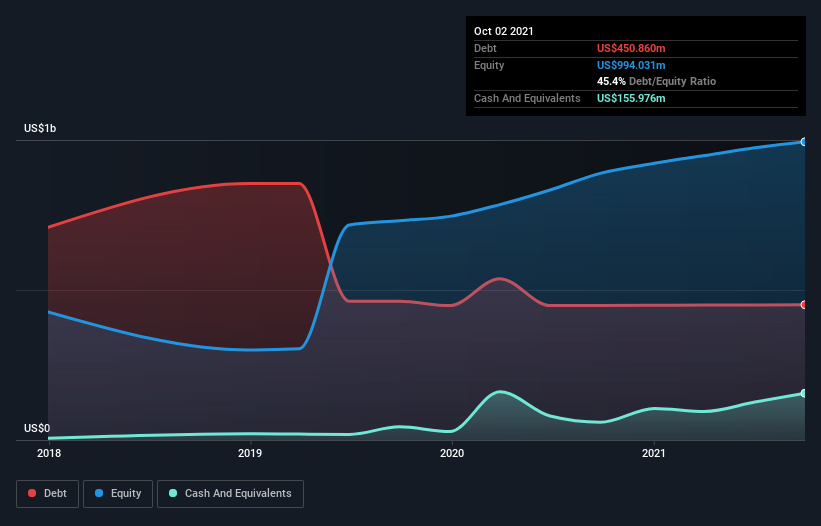- United States
- /
- Food and Staples Retail
- /
- NasdaqGS:GO
Does Grocery Outlet Holding (NASDAQ:GO) Have A Healthy Balance Sheet?

Some say volatility, rather than debt, is the best way to think about risk as an investor, but Warren Buffett famously said that 'Volatility is far from synonymous with risk.' When we think about how risky a company is, we always like to look at its use of debt, since debt overload can lead to ruin. We note that Grocery Outlet Holding Corp. (NASDAQ:GO) does have debt on its balance sheet. But is this debt a concern to shareholders?
What Risk Does Debt Bring?
Generally speaking, debt only becomes a real problem when a company can't easily pay it off, either by raising capital or with its own cash flow. In the worst case scenario, a company can go bankrupt if it cannot pay its creditors. However, a more common (but still painful) scenario is that it has to raise new equity capital at a low price, thus permanently diluting shareholders. Of course, plenty of companies use debt to fund growth, without any negative consequences. When we think about a company's use of debt, we first look at cash and debt together.
View our latest analysis for Grocery Outlet Holding
How Much Debt Does Grocery Outlet Holding Carry?
As you can see below, Grocery Outlet Holding had US$450.9m of debt, at October 2021, which is about the same as the year before. You can click the chart for greater detail. However, it also had US$156.0m in cash, and so its net debt is US$294.9m.

How Strong Is Grocery Outlet Holding's Balance Sheet?
Zooming in on the latest balance sheet data, we can see that Grocery Outlet Holding had liabilities of US$228.5m due within 12 months and liabilities of US$1.40b due beyond that. On the other hand, it had cash of US$156.0m and US$9.62m worth of receivables due within a year. So its liabilities outweigh the sum of its cash and (near-term) receivables by US$1.46b.
This deficit is considerable relative to its market capitalization of US$2.40b, so it does suggest shareholders should keep an eye on Grocery Outlet Holding's use of debt. Should its lenders demand that it shore up the balance sheet, shareholders would likely face severe dilution.
We use two main ratios to inform us about debt levels relative to earnings. The first is net debt divided by earnings before interest, tax, depreciation, and amortization (EBITDA), while the second is how many times its earnings before interest and tax (EBIT) covers its interest expense (or its interest cover, for short). The advantage of this approach is that we take into account both the absolute quantum of debt (with net debt to EBITDA) and the actual interest expenses associated with that debt (with its interest cover ratio).
Grocery Outlet Holding's net debt is sitting at a very reasonable 1.7 times its EBITDA, while its EBIT covered its interest expense just 6.4 times last year. While these numbers do not alarm us, it's worth noting that the cost of the company's debt is having a real impact. Grocery Outlet Holding grew its EBIT by 4.4% in the last year. That's far from incredible but it is a good thing, when it comes to paying off debt. There's no doubt that we learn most about debt from the balance sheet. But ultimately the future profitability of the business will decide if Grocery Outlet Holding can strengthen its balance sheet over time. So if you want to see what the professionals think, you might find this free report on analyst profit forecasts to be interesting.
Finally, a business needs free cash flow to pay off debt; accounting profits just don't cut it. So we always check how much of that EBIT is translated into free cash flow. In the last three years, Grocery Outlet Holding's free cash flow amounted to 49% of its EBIT, less than we'd expect. That weak cash conversion makes it more difficult to handle indebtedness.
Our View
Grocery Outlet Holding's struggle to handle its total liabilities had us second guessing its balance sheet strength, but the other data-points we considered were relatively redeeming. But on the bright side, its ability to to cover its interest expense with its EBIT isn't too shabby at all. Looking at all the angles mentioned above, it does seem to us that Grocery Outlet Holding is a somewhat risky investment as a result of its debt. That's not necessarily a bad thing, since leverage can boost returns on equity, but it is something to be aware of. Given our hesitation about the stock, it would be good to know if Grocery Outlet Holding insiders have sold any shares recently. You click here to find out if insiders have sold recently.
If, after all that, you're more interested in a fast growing company with a rock-solid balance sheet, then check out our list of net cash growth stocks without delay.
New: Manage All Your Stock Portfolios in One Place
We've created the ultimate portfolio companion for stock investors, and it's free.
• Connect an unlimited number of Portfolios and see your total in one currency
• Be alerted to new Warning Signs or Risks via email or mobile
• Track the Fair Value of your stocks
Have feedback on this article? Concerned about the content? Get in touch with us directly. Alternatively, email editorial-team (at) simplywallst.com.
This article by Simply Wall St is general in nature. We provide commentary based on historical data and analyst forecasts only using an unbiased methodology and our articles are not intended to be financial advice. It does not constitute a recommendation to buy or sell any stock, and does not take account of your objectives, or your financial situation. We aim to bring you long-term focused analysis driven by fundamental data. Note that our analysis may not factor in the latest price-sensitive company announcements or qualitative material. Simply Wall St has no position in any stocks mentioned.
About NasdaqGS:GO
Grocery Outlet Holding
Operates as a retailer of consumables and fresh products sold through independently operated stores in the United States.
Excellent balance sheet with moderate growth potential.
Similar Companies
Market Insights
Community Narratives



